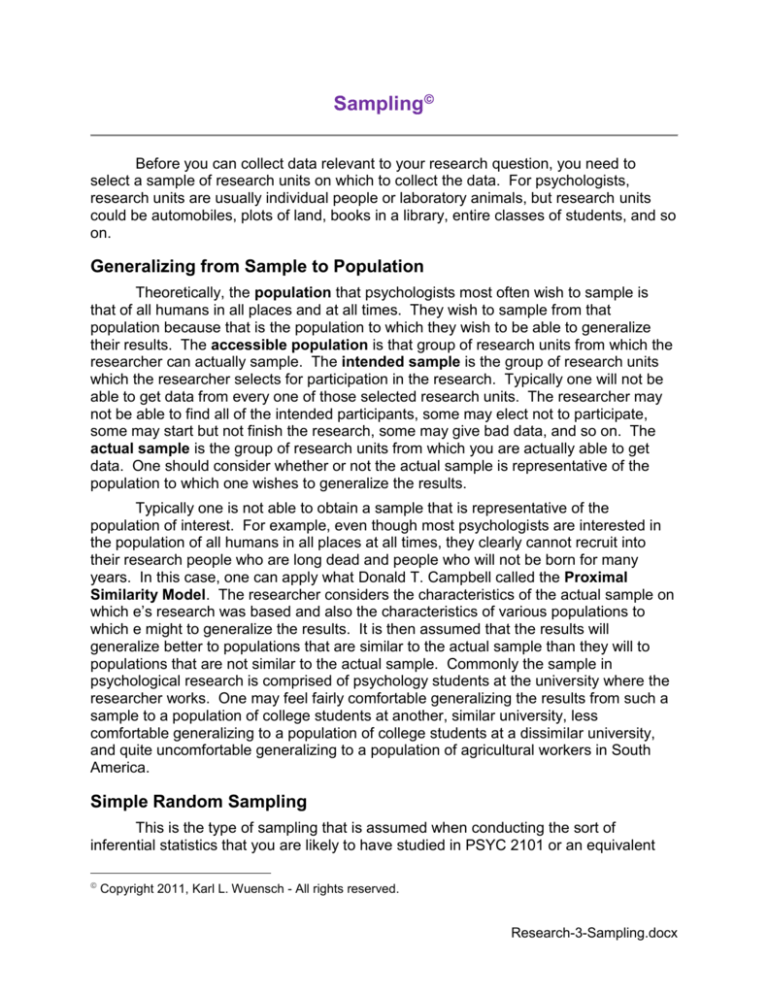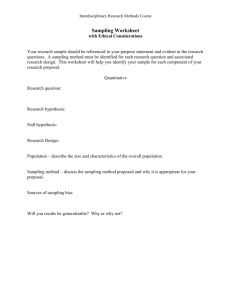
Sampling
Before you can collect data relevant to your research question, you need to
select a sample of research units on which to collect the data. For psychologists,
research units are usually individual people or laboratory animals, but research units
could be automobiles, plots of land, books in a library, entire classes of students, and so
on.
Generalizing from Sample to Population
Theoretically, the population that psychologists most often wish to sample is
that of all humans in all places and at all times. They wish to sample from that
population because that is the population to which they wish to be able to generalize
their results. The accessible population is that group of research units from which the
researcher can actually sample. The intended sample is the group of research units
which the researcher selects for participation in the research. Typically one will not be
able to get data from every one of those selected research units. The researcher may
not be able to find all of the intended participants, some may elect not to participate,
some may start but not finish the research, some may give bad data, and so on. The
actual sample is the group of research units from which you are actually able to get
data. One should consider whether or not the actual sample is representative of the
population to which one wishes to generalize the results.
Typically one is not able to obtain a sample that is representative of the
population of interest. For example, even though most psychologists are interested in
the population of all humans in all places at all times, they clearly cannot recruit into
their research people who are long dead and people who will not be born for many
years. In this case, one can apply what Donald T. Campbell called the Proximal
Similarity Model. The researcher considers the characteristics of the actual sample on
which e’s research was based and also the characteristics of various populations to
which e might to generalize the results. It is then assumed that the results will
generalize better to populations that are similar to the actual sample than they will to
populations that are not similar to the actual sample. Commonly the sample in
psychological research is comprised of psychology students at the university where the
researcher works. One may feel fairly comfortable generalizing the results from such a
sample to a population of college students at another, similar university, less
comfortable generalizing to a population of college students at a dissimilar university,
and quite uncomfortable generalizing to a population of agricultural workers in South
America.
Simple Random Sampling
This is the type of sampling that is assumed when conducting the sort of
inferential statistics that you are likely to have studied in PSYC 2101 or an equivalent
Copyright 2011, Karl L. Wuensch - All rights reserved.
Research-3-Sampling.docx
2
course. Sampling N data points from a population is random if every possible different
sample of size N is equally likely to be selected.
Obtain the sampling frame, a list of all of the members of the target accessible
population. For example, if your target population were students at ECU, the
sampling frame would be a listing of all students at ECU.
Assign to each member a random number, using a computer’s random number
generator. Now you have a table with two columns: Name of the member and
member’s number.
Now you sort the table by the random numbers.
Finally, you select the first n names in the sorted list, where n is the number of
participants you want to have in your sample. The sampling fraction is n N ,
where N is the number of members in the sampling frame.
The statistics you learned in PSYC 2101 assume that the sampling fraction is 0,
that is, that n is very small relative to N.
Stratified Random Sampling
Here you start by dividing your population into strata. Strata are nonoverlapping,
homogeneous subgroups. For example, you might divide your population of ECU
students in freshmen, sophomores, juniors, seniors, graduate students, and nondegree
students. Then you sample a specified number (ni) of subjects from each stratum. In
this way you are assured that each stratum of the population is going to be included in
your sample.
With proportionate stratified random sampling, you sample the same
proportion of each stratum. For example, suppose you decided to use a sampling
fraction of 10% (you want to include 10% of all ECU students in your sample). You then
randomly select 10% of the freshmen, 10% of the sophomores, 10% of the juniors, and
so on.
With disproportionate stratified random sampling, you use different sampling
fractions in the different strata. You are most likely to select this method when some of
the strata have relatively few members but you want to be sure to get a sufficiently large
number of subjects from each strata to be able to conduct powerful statistical analyses
(or parameter estimation with little error) within each stratum. For our example, we
might decide to sample a larger proportion of graduate students and nondegree
students than freshmen and sophomores because there are so few graduate students
and nondegree students here that 10% of them would be a lot fewer than 10% of
freshman and sophomores.
Cluster Random Sampling
This technique may save a lot of effort when you are sampling across a wide
geographic region. Suppose that you wanted to sample mayors in North Carolina. You
divide the state into clusters. For example, you could consider each county a cluster.
3
You would then randomly sample a few counties and gather data on every mayor in the
selected counties.
Multi-Stage Random Sampling
Here you combine two or more of the techniques we have discussed so far. For
example, suppose you want to sample students at ECU. You could consider classes to
be your clusters and select 100 classes. From each of those 100 classes you could
then select a simple random sample of 5 students.
Nonrandom Methods of Sampling
Sometimes it is just too much trouble to get a random sample or you have
decided not to employ any statistical techniques that demand random sampling In
these cases you may use a nonrandom sampling technique such as one of those listed
below.
Convenience Sampling
Also called accidental or haphazard sampling. Here you just use an easy to get
sample. For example, you put up a sign-up sheet on the bulletin board in the Rawl
Building offering extra credit in PSYC 1000 to those who volunteer to participate. To
whom can you generalize the results? I guess to the population of students in
introductory psychology at ECU who volunteer in such situations, and to any other
populations that you think adequately similar to that population.
Purposive Sampling
Here you are targeting a particular population but are not worried about randomly
sampling subgroups within that population. For example, suppose that you want to
sample African-American students at ECU who are not residents of North Carolina.
You to out by the Wright Place and approach people who look like they might fit the
criteria for selection. After verifying that the subject does meet the criteria, you solicit
participation. Of course, the resulting sample may not be a representative sample of
the targeted population. Not all members of the target population may be equally likely
to be found near the Wright Place at the time you are sampling.
All of the following are particular types of purposive sampling:
Modal Instance Sampling
Here you define what is the “typical” member of the target population and then
gather data from only such typical members. For example, the modal student at ECU
may be a female, 18 years of age, and from Pitt county. You then target students who
have those modal characteristics. Of course, those students may differ greatly from
other students at ECU on the variable you will be measuring. Suppose you were asking
“how often do you visit your parents during the school year?” Would the response of
the modal student be representative of that of the entire population of ECU students?
Expert Sampling
Here you gather a group of persons known to be expert with respect to the
information you seek. For example, suppose you are constructing a questionnaire that
4
is designed to measure how socially aggressive a person is. You write a large number
of potential items and now you want some help determining which items would be most
appropriate to include on such a questionnaire. You gather a group of psychologists
with expertise in constructing questionnaires like this and ask their opinions about the
items.
Quota Sampling
With proportional quota sampling you want to get a sample that represents
each of two or more subgroups in the same proportions that they are represented in the
population, but you can’t be bothered with stratified random sampling. Suppose your
population is undergraduate students at ECU. You know that 30% are freshmen, 30%
are sophomores, 20% are juniors, and 20% are seniors. You want a sample of 50, so
you need 15 freshmen, 15 sophomores, 10 juniors, and 10 seniors. You approach
students by the Wright Place, determine their class standing, and solicit their
participation. Once you have the predetermined number of subjects in any category,
you no longer accept participation by any additional persons in that category.
With nonproportional quota sampling you specify the minimum number of
subjects you want in each subgroup. For example, and then you just keep gathering
data until you have at least that many in each subgroup.
Heterogeneity Sampling
Here you want to be sure to include in your sample people with diverse opinions.
Suppose that you are interviewing college students about reinstituting the military draft
and student exemptions from the draft. Suppose that most students think that the draft
should not be reinstituted or that if it is then students should be exempt. Suppose that a
few students think that there should be no student exemption. Suppose that an even
smaller number of students think that all persons should be drafted into mandatory
public service as soon as they graduate from or drop out of high school, before going to
college. You might well want to interview people with all four of these types of opinions,
even those who have a minority opinion.
Snowball Sampling
Here you start by identifying people who meet your criteria for inclusion in the
study and then you ask each of them to recommend others that also meet those criteria.
In other words, you ask your participants to help you recruit additional participants.
Although the resulting sample may well not be representative of the target population,
this can be a very easy way to find people who do meet your criteria for inclusion,
assuming that birds of a feather flock together (or at least know where to find one
another).
Copyright 2011, Karl L. Wuensch - All rights reserved.










